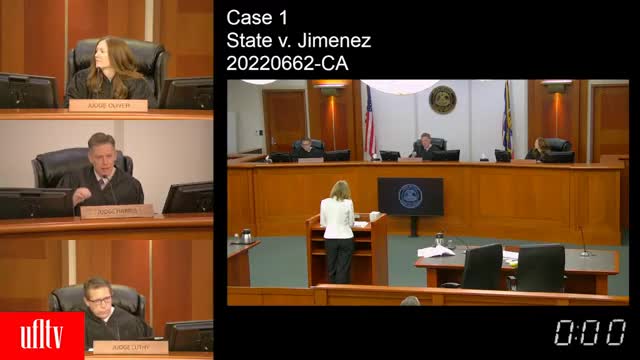Prosecutor highlights key events in defense's case against alleged molestation
May 24, 2025 | Utah Appellate Court Collection, Utah Family Law District Court Collection, Utah District Courts, Utah Judicial Branch, Utah
This article was created by AI summarizing key points discussed. AI makes mistakes, so for full details and context, please refer to the video of the full meeting. Please report any errors so we can fix them. Report an error »

In a recent government meeting discussing the Utah Court of Appeals case, State v. Jimenez, significant attention was given to the prosecution's strategy in presenting evidence to the jury. The discussions highlighted the prosecutor's approach of linking multiple events to strengthen the case against the defendant, Jimenez. This tactic aims to create a narrative that emphasizes the severity and frequency of the alleged offenses.
One key point raised was the prosecutor's focus on specific incidents, particularly those that occurred in the defendant's bedroom. The prosecutor referenced a hug and an incident where the victim was pulled into bed, suggesting that these actions were pivotal in establishing a pattern of behavior. The defense, however, pointed out that the victim herself expressed uncertainty about some details of her testimony, including whether certain events occurred or were merely dreams. This ambiguity raises questions about the reliability of the victim's recollections and how they might influence the jury's perception.
The discussion also touched on the potential impact of jury instructions regarding unanimity. The defense argued that if jurors are instructed to reach a unanimous decision, they may gravitate towards the more concrete incidents presented by the prosecution, potentially overlooking the nuances of the victim's testimony. The prosecutor's strategy of concentrating on specific, detailed accounts of abuse could sway the jury's understanding and decision-making process.
Overall, the meeting underscored the complexities involved in legal proceedings, particularly in cases of alleged sexual offenses. The interplay between the prosecution's narrative and the defense's challenges highlights the critical role that jury perceptions play in the outcome of such cases. As the court continues to deliberate, the implications of these discussions will be closely monitored, as they may set precedents for future cases involving similar allegations.
One key point raised was the prosecutor's focus on specific incidents, particularly those that occurred in the defendant's bedroom. The prosecutor referenced a hug and an incident where the victim was pulled into bed, suggesting that these actions were pivotal in establishing a pattern of behavior. The defense, however, pointed out that the victim herself expressed uncertainty about some details of her testimony, including whether certain events occurred or were merely dreams. This ambiguity raises questions about the reliability of the victim's recollections and how they might influence the jury's perception.
The discussion also touched on the potential impact of jury instructions regarding unanimity. The defense argued that if jurors are instructed to reach a unanimous decision, they may gravitate towards the more concrete incidents presented by the prosecution, potentially overlooking the nuances of the victim's testimony. The prosecutor's strategy of concentrating on specific, detailed accounts of abuse could sway the jury's understanding and decision-making process.
Overall, the meeting underscored the complexities involved in legal proceedings, particularly in cases of alleged sexual offenses. The interplay between the prosecution's narrative and the defense's challenges highlights the critical role that jury perceptions play in the outcome of such cases. As the court continues to deliberate, the implications of these discussions will be closely monitored, as they may set precedents for future cases involving similar allegations.
View full meeting
This article is based on a recent meeting—watch the full video and explore the complete transcript for deeper insights into the discussion.
View full meeting

